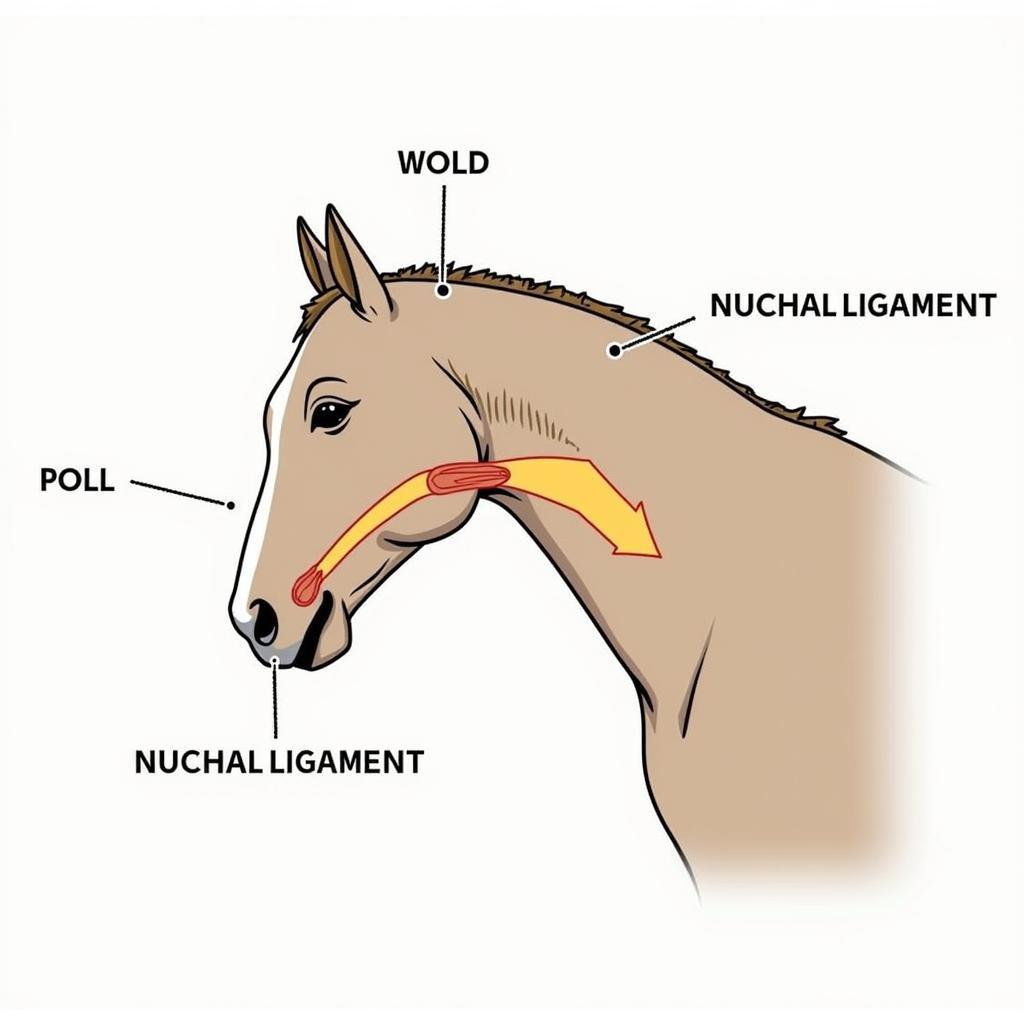The horse’s neck, a powerful and graceful structure, plays a crucial role in its movement, balance, and overall well-being. Understanding Horse Neck Anatomy is essential for any horse owner, rider, or enthusiast. This article delves into the intricate details of this vital part of the equine body, explaining its structure, function, and importance.
The horse’s neck is a complex network of muscles, ligaments, tendons, and bones, all working together to allow a wide range of motion, from grazing to galloping. Proper care and understanding of this intricate system is essential for maintaining the horse’s health and performance. Let’s explore the fascinating world of horse neck anatomy.
Key Components of Horse Neck Anatomy
The horse’s neck is composed of seven cervical vertebrae, which are the bones that make up the spinal column in the neck. These vertebrae are connected by intervertebral discs, which act as cushions, absorbing shock and allowing flexibility. The first cervical vertebra, also known as the atlas, connects directly to the skull and allows for the up and down movement of the head. The second vertebra, the axis, allows for the side-to-side rotation of the head.
The Nuchal Ligament: Supporting the Head and Neck
The nuchal ligament is a strong, elastic structure that runs along the top of the neck, from the poll (the back of the skull) to the withers (the highest point of the shoulders). This ligament acts like a suspension bridge, supporting the weight of the horse’s head and neck. It allows the horse to graze comfortably and helps to maintain balance and posture. Damage to the nuchal ligament can severely impact a horse’s movement and comfort.
 Horse Neck Nuchal Ligament Function
Horse Neck Nuchal Ligament Function
Muscles: Powering Movement and Flexibility
A complex network of muscles controls the intricate movements of the horse’s neck. These muscles work together to flex, extend, rotate, and laterally bend the neck. Some of the key muscles include the splenius muscle, which is responsible for extending and raising the neck, and the brachiocephalicus muscle, which helps to flex the neck and draw the head downwards. Understanding these muscles and their functions is crucial for effective training and preventing injuries. Learn more about the horse splenius muscle.
Why is Horse Neck Anatomy Important?
Understanding horse neck anatomy is essential for numerous reasons. For riders, it allows for a deeper understanding of how the horse moves and responds to aids. This knowledge is crucial for effective communication and training. Proper riding techniques, considering the horse’s natural movement and the functionality of its neck, are key to preventing injury and promoting a harmonious partnership between horse and rider. More on horse reins parts can help understand how to handle the reins for better communication. You can also learn about the external anatomy of a horse for a broader understanding.
For veterinarians and equine therapists, a thorough knowledge of horse neck anatomy is crucial for diagnosing and treating injuries and conditions affecting the neck. This includes recognizing the signs of common ailments, such as arthritis, muscle strains, and nerve damage. Early diagnosis and appropriate treatment are crucial for minimizing the long-term impact of these issues. This detailed understanding of the neck also helps them to provide the most effective treatments.
“A thorough understanding of horse neck anatomy is not just for professionals,” says Dr. Amelia Hayes, DVM. “Every horse owner should have a basic grasp of how this vital structure works. This knowledge allows for better care, early detection of potential problems, and a deeper appreciation for the horse’s athleticism.”
Common Questions About Horse Neck Anatomy
What are the common causes of neck pain in horses?
Neck pain in horses can be caused by a variety of factors, including arthritis, muscle strains, nerve compression, and ill-fitting tack.
How can I tell if my horse has a neck injury?
Signs of a neck injury in a horse can include stiffness, reluctance to turn or bend the neck, head tilting, and changes in gait.
What is the best way to prevent neck injuries in horses?
Preventing neck injuries involves proper riding techniques, ensuring correct saddle fit, providing adequate turnout, and avoiding sudden or jerky movements. More about parts of horse reins will help in this.
What are the treatment options for neck injuries in horses?
Treatment options vary depending on the specific injury and can include rest, medication, physical therapy, and in some cases, surgery.
Why is the nuchal ligament so important?
The nuchal ligament plays a crucial role in supporting the weight of the horse’s head and neck, allowing for efficient movement and grazing.
How many vertebrae are in a horse’s neck?
A horse has seven cervical vertebrae in its neck. You can also find more information about the horse anatomy neck.
What are the key muscles involved in neck movement?
Some of the key muscles involved in neck movement include the splenius, brachiocephalicus, and rhomboideus muscles.
In conclusion, understanding horse neck anatomy is crucial for ensuring the well-being and optimal performance of these magnificent animals. From the complex interplay of bones and muscles to the vital role of the nuchal ligament, each component contributes to the horse’s grace, power, and overall health. By deepening our knowledge of this intricate structure, we can better care for, train, and appreciate the athleticism and beauty of the horse.
For further information or assistance with your horse’s care, please contact us at Phone Number: 0772127271, Email: [email protected] Or visit us at QGM2+WX2, Vị Trung, Vị Thuỷ, Hậu Giang, Việt Nam. We have a 24/7 customer service team.